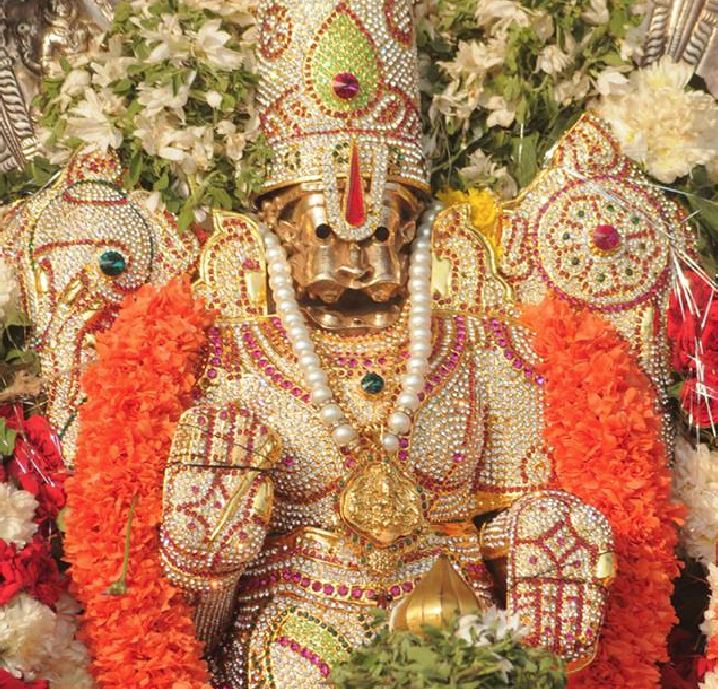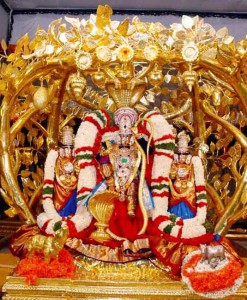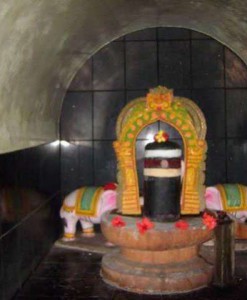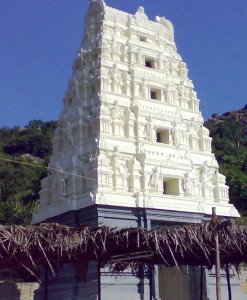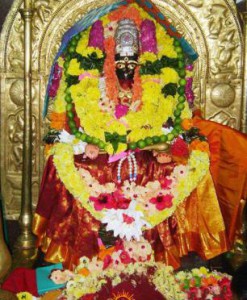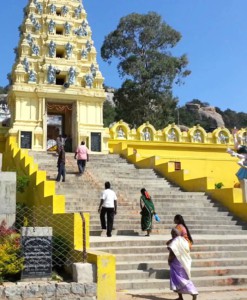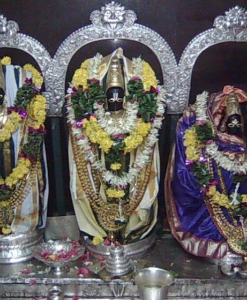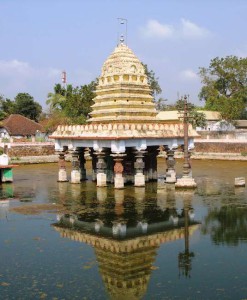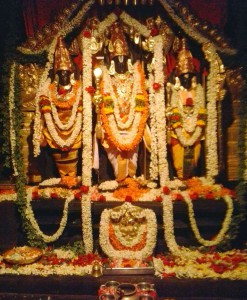No products in the cart.
Mangalagiri is one of the oldest Vaishnavite Temples in South India. Sri Lakshmi Narasimha Swamy is the deity in this holy place. 11 storied lofty Gali Gopuram (Temple Tower) is a main attraction to pilgrims as well as tourists. It was built by the then Zamindar Sri Raja Vasireddy Venkatadri Naidu during the period 1807-1809 and it has completed 200 years of its construction. While the people are looking forward to celebrate its Bi-Centenary of its construction, it was learnt through media that the Government of Andhra Pradesh has taken a decision to demolish it and to reconstruct a new Gopuram in its place, which is not being digested by the devotees and public.
The background for the decision of government is – an old gali gopuram at Srikalahasti constructed during the period of Vijayanagara Kingdom was fallen down causing heartening feelings among devotees and public. Then the government has sent an expert Technical Committee to inspect Mangalagiri to give report on its strength. The expert Technical Committee has given its recommendations suggesting some measures to protect the same. To the surprise of public, instead of taking remedial measures suggested by the committee, Government has taken a hard decision to demolish Mangalagiri Gali Gopuram and to construct a new one in its place with an estimated cost of Rs.10.5 crore.
Some voluntary organizations and public are agitating against government’s decision. An expert committee which inspected the Gali Gopuram, on behalf of public has given its opinion that there is no immediate danger to the Gopuram. They have suggested that the Gali Gopuram can be protected with an approximate cost of Rs.1 crore by Ground Improvement Methods.
Panakala Lakshmi Narasimha Swamy Temple
Since 225 B.C., Mangalagiri was ruled by great kings. Andhra Satavahanas ruled from 225 B.C. to 225 A.D. with Dhanya Katakam as the capital. From 225 A.D. to 300 A.D., Ikshwakus ruled. Since 300 A.D., Pallavas started ruling. After that Ananda Gotrajas ruled with Kanteru as the capital. Vishnu Kundeenas ruled from 420 A.D. to 620 A.D. Madhava Verma-2, who is in the generation of Vishnu kundeenas ruled with Vijayawada as the capital. Since 630 A.D., Chanakyas ruled.
After Palnati war in 1180 A.D., Mangalagiri was ruled by Kakateeyas. In 1323, Delhi sultans defeated Kakateeyas, and Mangalagiri came under the control of them. In 1353, Reddi kings ruled with Kondaveedu as the capital. In 1424, kondaveedu kingdom demolished, and Mangalagiri came under the rule of Gajapathi kings in Orissa.
In 1515, Andhra Bhoja, Sri Krishnadeva Raya defeated Gajapathi kings and he started ruling. Mangalagiri is one of the 200 towns in Vijayanagara kingdom. In 1565, in the Tallikota war, Vijayanagar kingdom was destroyed, and Golkonda Kuthub Shahi started ruling. Golkonda sultan divided kondaveedu into 14 parts, and Mangalagiri was one part in that. In Mangalagiri, there were 33 villages at that time. From 1750-1758, it was under the rule of French, and from 1758-1788, it was under the rule of Nijams.
On 18-9-1788, Hyderabad navab, Nijam Alikhan gave Guntur to British people. They made Raja Vasireddi Venkatadri Naidu as Jamindar of this place. He constructedGali Gopuram (big tower) for the temple. From 1788-94, Circuit Committee of East India company ruled Mangalagiri. In 1794, Circuit committee was cancelled, and with 14 mandals, Guntur district was formed. In 1859, Guntur district was merged in Krishna district, and on 1-10-1904, it was separated. Since then, Mangalagiri has been a part of Guntur district.
Mangalagiri means The Auspicious Hill. This place is one of the 8 important Mahakshetrams (sacred places) in India. The eight places where Lord Vishnu manifested himself are (1) Sri Rangam (2) Srimushnam (3) Naimisam (4) Pushkaram (5) Salagamadri (6) Thothadri (7) Narayanasramam (8) Venkatadri. Thotadri is the present Mangalagiri. Lakshmi Devi has done tapas on this hill. That’s why it got this name (The auspicious hill). There are three Narasimha Swamy temples in Mangalagiri. One is Panakala Narasimha Swamy on the hill. Another one is Lakshmi Narasimha Swamy at the foot of the temple. Third one is Gandala Narasimha Swamy at the top of the hill.
This shape of the hill looks like an elephant. From all the directions, the hill appears in the elephant shape only. There is an interesting legend to show as to how the mountain came into existence. Pariyatra, an ancient king had a son Hrasva Srungi visited all holy and sacred places to regain normal bodily stature and finally visited this holy place of Mangalagiri and stayed for three years performing penance. All the Devathas (Gods) advised him to stay at Mangalagiri and continue to do penance in praise of Lord Vishnu. The father of Hrasva Srungi came with his retinue to take back his son to his kingdom. But Hrasva Srungi took the shape of an elephant to become the abode of Lord Vishnu who is locally known as Panakala Lakshmi Narasimhaswamy.
The temple of Sri Panakala Lakshmi Narasimhaswamy is situated on the hill. On the right side of the steps provided to reach the temple, there is a stone inscription by Sri Krishnadeva Raya of Vijayanagar and a little further up, the foot prints of Mahaprabhu Chaitanya are to be seen. Midway on the steps there is a temple of Lord Panakala Lakshmi Narasimhaswamy there is only the face with the mouth widely opened. A dhwajasthambham was erected in front of the temple in 1955. Behind the temple there is the temple of Sri Lakshmi, to the west of which there is a tunnel which is believed to lead to Vundavalli caves on the banks of the Krishna. The stone inscription of the kings of Vijayanagar relate besides to the conquest of Rayalu over Kondapalli etc., that Siddhiraju Thimmarajayya Devara granted a total of 200 kunchams (10 kunchams make one acre) land in 28 villages of which Mangalagiri was one and gift of 40 kunchams by China Thirumalayya to Ramanujakutam.
The steps to the temple were constructed by Sri Channapragada Balaramadasu in 1890. There was a cave next the devi temple on the hill. It is said that, there is a way to Vundavalli from that cave, and the sages used to go by that way to take bath in Krishna River. Now, the cave is very dark, and the way could not be seen.
Panakala Lakshmi Narasimha Swamy Temple Timings
Morning 07-00 Opening the doors
07-00 to 07-30 Morning Archana
07-30 to 01-00 Special Archana for the devotees and offering Panakam
01-00 Maharnivedana
03-00 Closing the doors
It is said that, in the evenings, Gods, and Sages worship the Lord. So, there is no Archana in the evenings.
Sri Lakshmi Narasimha Swamy Temple Timings
Morning 05-00 Opening the doors
05-30 Offering the Theertham
06-00 Morning Archana
07-30 Ghoshti (Using the theertham offering)
07-30 to 11-00 Special Archana for the devotees
11-30 Maharnivedana
12-30 Closing the doors
Evening 04-00 Opening the doors
04-00 to 07-00 Special Archana for the devotees
07-30 Evening Archana, Harathi, Theertha Ghoshti
08-30 Closing the doors
At the foot of the hill, there is another temple whose origin is traced to the time of Yudhishtira, the eldest of the pandavas. Yudhishtira is said to be the founder of the chief image of this temple and the deity here is called Sri Lakshmi Narasimha Swamy. In Vijayawada itself, which is 8 miles from Mangalagiri there is a hill called Indrakeeladri in which Arjuna is said to have done tapascharya (penance) in order to obtain the weapon Pasupata from Lord Siva.
About 200 years back Raja Vasireddy Venkatadri Naidu who ruled from Amaravati as his capital constructed a stupendous gopuram (tower) on the eastern gate of the Lakshmi Narasimhaswamy. It is one of the highest gopurams in South India and only one of its type in this part of India. It is 153ft. in height and 49 feet wide with 11 storeys, and gates facing east and west. This great and imposing tower dwarfs the central shrine. The devoted patience of thousands of skilled craftsmen and the labour of many more apprentices which had gone into this great structure is a testimony to the religious fervour which characterized the builder. After constructing the gopuram, it was leaning towards one direction. The Kancheepuram Architects suggested to dig a tank opposite to the tower. After digging the tank, it is said that, the tower became straight.

